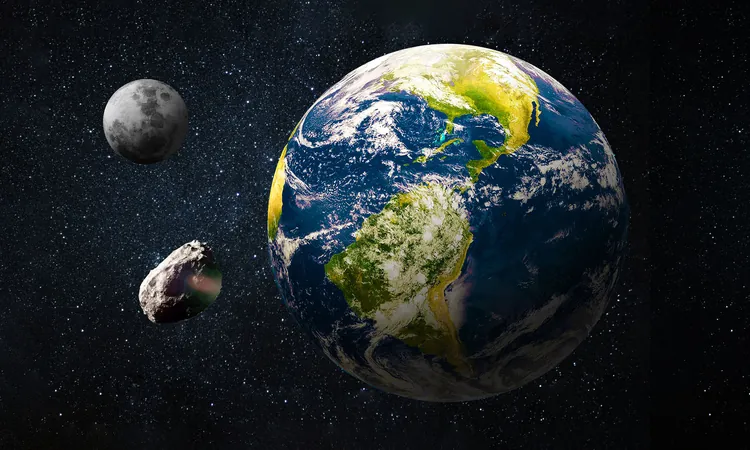
Earth’s Transient Companion: The Mini-Moon 2024 PT5 Will Soon Fade Away!
2024-11-04
Author: Jessica Wong
Introduction
On September 29, 2024, Earth welcomed an intriguing cosmic guest—a tiny asteroid known as 2024 PT5 which was temporarily captured, turning it into a mini-moon! This fascinating occurrence marks a rare moment when our planet boasted two moons, albeit briefly.
Significance of Mini-Moons
On November 2, 2024, astronomer Richard Binzel from the Massachusetts Institute of Technology (MIT), noted the significance of these temporary celestial companions. “Such happenings occur more frequently than we realize, but they're often too small and faint to detect. Recent advancements in telescope technology have improved our chances of spotting them,” he explained.
Identification of 2024 PT5
The asteroid 2024 PT5 was initially identified by NASA's Asteroid Terrestrial-impact Last Alert System (ATLAS) on August 7, 2024, at Haleakala Observatory in Hawaii. Following this, astronomers from Complutense University in Madrid utilized a telescope in Sutherland, South Africa, to further monitor this mini-moon.
What is 2024 PT5?
But what exactly is 2024 PT5? This asteroid measures only about 37 feet across, dwarfing our familiar moon, which is over 2,159 miles in diameter. For context, our moon is over 300,000 times larger than this transient visitor!
Gravitational Capture
These tiny asteroids occasionally find themselves in Earth's gravitational field. While most asteroids follow their orbits around the sun, some venture close enough to be temporarily ensnared by Earth’s gravity. However, 2024 PT5 is expected to drift away and resume its solar journey by mid-November, leaving us with only memories of its fleeting presence.
Scientific Opportunity
The unique nature of each mini-moon, including 2024 PT5, provides scientists with a fantastic opportunity to study near-Earth asteroids. Binzel referred to these captures as "natural cosmic laboratories" that allow researchers to learn more about the small bodies sharing our solar system.
The Arjuna Asteroids
The asteroid is part of a group called Arjuna asteroids, which travel alongside Earth as we orbit the sun. Analogy time: Picture a skateboarder smoothly riding through a skate park. Similarly, 2024 PT5 is caught in Earth’s orbit, experiencing the gravitational pull before breaking free.
Challenges of Detection
Despite the excitement surrounding 2024 PT5, spotting mini-moons is no easy feat. These small cosmic wanderers are often difficult to see due to their size and the challenges posed by space. Modern telescopes equipped with sophisticated detectors are required for astronomers to identify them. The ATLAS project actively scans the night skies, looking for objects that seem out of place—an effort requiring both technology and collaboration.
Future Implications
This latest visit by 2024 PT5 is not just an interesting phenomenon; studying it helps us understand how asteroids might interact with Earth in the future, potentially assisting us in preventing any possible threats. Knowing how to alter the trajectory of an asteroid can be crucial for planetary defense.
Pondering Future Missions
Looking ahead, experts are already pondering the possibilities of future missions. Imagine sending satellites or probes to investigate asteroids when they come close! There’s also potential for asteroid mining, which could lead to revolutionary discoveries. “These bodies could hold materials vital to technology and medicine that we can’t find on Earth,” said astronomer William Blackmore.
Conclusion
In conclusion, while 2024 PT5 might not be visible to most of us and will soon vanish from Earth's orbit, its brief stay serves as a captivating reminder of our ever-evolving cosmic environment. As our technology improves, who knows what other transient treasures await discovery in the vast expanse of space? Don't miss out on appreciating these mini-moons while they last!



 Brasil (PT)
Brasil (PT)
 Canada (EN)
Canada (EN)
 Chile (ES)
Chile (ES)
 España (ES)
España (ES)
 France (FR)
France (FR)
 Hong Kong (EN)
Hong Kong (EN)
 Italia (IT)
Italia (IT)
 日本 (JA)
日本 (JA)
 Magyarország (HU)
Magyarország (HU)
 Norge (NO)
Norge (NO)
 Polska (PL)
Polska (PL)
 Schweiz (DE)
Schweiz (DE)
 Singapore (EN)
Singapore (EN)
 Sverige (SV)
Sverige (SV)
 Suomi (FI)
Suomi (FI)
 Türkiye (TR)
Türkiye (TR)